Filed under: Action, Housing, Interviews, Northwest
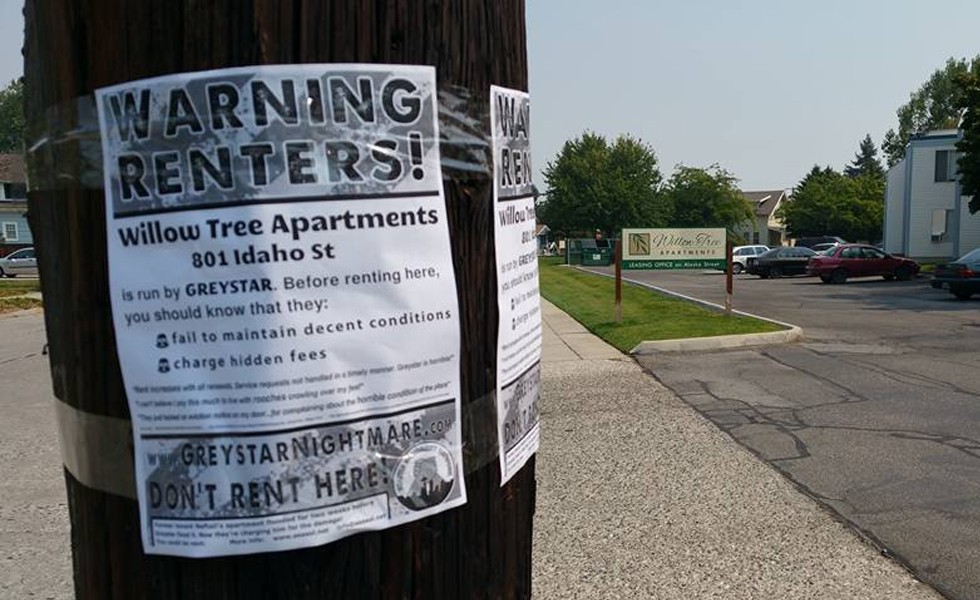
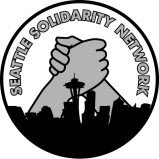
Originally posted to It’s Going Down
The Seattle Solidarity Network is a group based around the anarchist principles of direct action, mutual aid, and solidarity. They help fight against wage-theft, stolen deposits by landlords, harassment on the job, evictions, lock-outs of tenants, and other issues that working-class and poor people run into on a daily basis. Using a variety of tactics, the group attempts to hurt a boss or landlords bottom line: by costing them money. Some of their fights have led to strikes and mass pickets. Moreover, they work to bring together various social networks and people into the organizing, building up the confidence of everyday people to fight against the institutions and individuals which make their lives miserable. While SeaSol and other Solidarity Network type groups have been around for a while, when we heard that a recent SeaSol fight went national and then international, we had to know more. Hitting up our friends at SeaSol, they connected us to a member who sat down to talk about their recent fight against Greystar Real Estate Management.
IGD: Can you briefly give readers a short history of Seattle Solidarity Network and what it does and the kind of tactics that it uses?
Seattle Solidarity Network was founded by community members including Seattle Industrial Workers of the World (IWW, a radical anti-capitalist union) branch members back in 2007, I believe. As such, the organizing methods that we put into use are heavily borrowed from the IWW including their “A-E-I-O-U” model or Agitate, Educate, Inoculate, Organize, and Unite. We never take on a fight in which the individual at the center of it is not prepared to go all-in, so to speak. We don’t take on fights FOR people but rather WITH people which we feel helps empower individuals and hopefully shapes their behavior when confronting systems of control in the future.
As for tactics, we appreciate a diversity of tactics and are constantly trying to think outside of the box. From what I have seen though, some of the most effective methods we have used thus far focus on one individual such as a property owner who contracted has out to a shady company. By focusing on one individual, we can more easily gain leverage for ensuring that our demand is eventually met. But again, a diversity of tactics is always encouraged at SeaSol.
Demand deliveries [the act of a large group of people handing over a letter with demands to an employer or landlord, generally how a Solidarity Network fight starts], typically involve us determining one specific person that we would like to focus on. In the Greystar fight it was the top dog of the region but in other fights it has been specific property managers that have wronged tenants, specific managers that withheld tips, and so on. This adds an extra layer of pressure to the individual to quickly rectify the situation because they are being highlighted by our demand delivery, often in front of their peers or coworkers as opposed if we simply mailed a demand to Greystar’s offices. We usually give them a week to comply with the demand, which we carefully deliberate on to make sure it is both a winnable demand as well as fair and agreeable to whoever is at the center of the fight.
For a demand delivery, we do a mobilization of our members to get a decent sized group present for it. This ensures a level of safety and strength when presenting ourselves and demands to a large company especially. It also makes for some pretty hilarious Benny Hill-esque scenes such as with our Greystar delivery where we had to figure out how to get 25 people up to their 6th floor office in these tiny elevators without being too obvious. We like to make sure that the demand is read by somebody at the location we are delivering it to, (something we failed to do at the Greystar delivery), so that way we know for a fact that at least somebody did read it rather than just explicitly ignore it. After the delivery is done, we clap as we exit the offices just to add an extra level of discomfort for our targets and to draw attention to the action. Demand deliveries are many members’ favorite actions because they are somewhat directly confrontational and you really get to see some terrible people squirm.
Pickets are pretty typical when we implement them, though we have mixed it up before with some noise demos rather than a traditional picket. I know the fight that we won just prior to my signing on with SeaSol involved a sketchy company contracted by a property management company to clean their condos. The sketchy company utilized undocumented workers and often took advantage of them until one who hadn’t been paid for over a week’s worth of work got a hold of us. SeaSol mobilized to the apartment complex the individual at the center of the fight had worked on at 8am on a Sunday morning and raised all sorts of a ruckus. The residents were none too happy about it but literature was provided informing them that their property manager had hired somebody with exploitative business practices to take care of their building and encouraged them to ask them to drop the person. Within another 2 weeks, the contractor paid our friend in full after the property manager threatened to drop him.
For postering, we encourage people to always work in teams for safety in case of a confrontation or police interaction. We often use postering as a “first action” for newer folks who just recently signed up for our email list or phone tree. This offers our more established members a chance to gauge their desire to be involved and to begin building a relationship with them. As with any organization, keeping new faces coming in and participating to prevent burnout is always the biggest challenge. This is a fairly useful tool for helping facilitate that.
IGD: Can you talk about this latest campaign that ended up using groups in a variety of cities (and two countries) to win a victory? How did this campaign come about and what caused these people to contact Sea Sol?
So this fight came to our attention because the individual at the center of it had organized with SeaSol in the past (a great example of initial activity with SeaSol empowering somebody to stand up for themselves down the road!). When he went to his Greystar property manager to dispute the nearly $600 in charges for damages caused by their shitty plumbing, she smirked and told him he could hire a lawyer if he desired to to which his reply was, “The lawyers are your friends, I will call MY friends at SeaSol,” which I think is pretty badass. The best part about working with this person was it wasn’t just him, he got his husband, their friend who recently moved to the country and was staying with them, and his older father all involved as well. It was really powerful for me personally watching this entire family rally to use direct action to take back what was essentially stolen from them.
IGD: What strategy did Sea Sol use to fight this campaign? Why?
So when we began planning for this fight, it very quickly became clear just how large Greystar was. While this traditionally would be cause for concern or reservations about the fight, organizers saw this actually as a weakness. Rather than having just one building that they could easily get a no-contact or no-trespass order against us at, they had literally thousands of buildings from coast to coast and even in the UK and Mexico for us to target.
Postering has always been a first step for campaigns and this one was no different in that regard but given the size of Greystar, we decided to up the ante for our initial action. Since they came to the table so quickly to settle, we had no time to implement anything other than our postering campaign which while awesome, was a little bit of a let down for those working on other plans haha. But victory for our friend at the center of the fight always comes first and ultimately it is their call on how they want to settle. We can only encourage them to stick to their guns and were happy to see that this was the case in this particular fight.
One thing I really would like to say along those lines is that when they came to the table ready to settle with our friend, they initially offered to pay up “a week after a settlement is signed” to which we immediately declined, citing a complete lack of trust and goodwill from Greystar. Then, just a day or two later they came back saying they had the money ready and wanted to sit down. Our friend agreed to meet with them along with 2 other SeaSol members for support and we discussed tactics for the meeting the night prior. It was suggested by the group and accepted by our friend that he would sign NO settlement that included a non-disclosure agreement or non-disparagement agreement because these would be tools that would silence us from being able to show others that Greystar can be beat and potentially leave our friend open to legal ramifications.
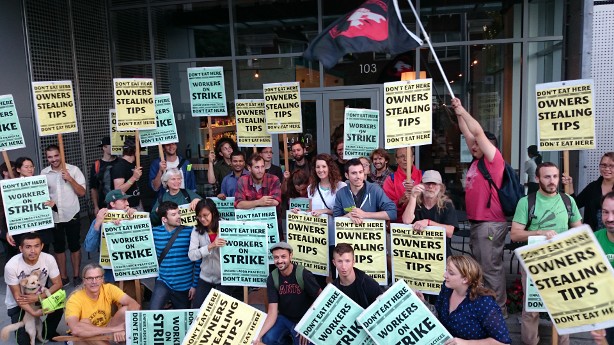
At the meeting, they still insisted on leaving that language in the settlement so our team simply got up and walked out. What happened next is my favorite part of the entire ordeal; Greystar’s regional guy chased them down while striking out the bad language from the settlement and handed the check over.
One of SeaSol’s principles when taking on and planning a fight is a chain of escalation. Right off the bat when we take on a fight, we sit and brainstorm a bevy of different tactics we could potentially use to win the fight and then try and rank them from weakest to strongest. The reasoning here is that if we use our strongest tactics first and they don’t budge yet on our demands, then we have completely hamstrung ourselves for the rest of the fight. By implementing the smaller actions first, we give them time to get really uncomfortable and a steady escalation of tactics gives the impression to them that we well organized and ready to go the distance. That’s where the decision to begin with a postering campaign came from. We saw it as a way to grab their attention and then from there we could ratchet up the pressure on them with more intensive actions such as pickets/demos of properties during open houses and so on.
As far as the timeline goes, we began postering as soon as we hit a week after the demand delivery with no solution. We then spent the next 2 weeks ramping up the postering campaign as our comrades in other cities and countries began putting up posters. While the exact dates escape me, it was roughly a month from the demand delivery to when our friend was paid back.
IGD: How did you end up getting other groups from other cities involved in this campaign, how was this successful?
Our fight committee got together and went through every city that Greystar had a presence in and made a spreadsheet of every possible contact in those cities, whether it be IWW chapters, other SolNets, anarchist organizations, or even just individuals who we knew and trusted that would jump at a chance to help us out. It was really as simple as contacting folks in all these different places and providing them with posters that included the name and address of specific locations to print out and put in visible spots near each building. We asked people who agreed to help to send pictures for both agitprop purposes and as a way of encouraging them to follow-through on their offers to assist us.
Just 2-4 posters per building across many of their holdings was clearly enough to raise the alarm and get the upper echelons of their management to contact one of the regional guys here in Seattle and say something along the lines of, “Look, make this problem go away or you will be personally held responsible.” This leverage really helped ensure that our demands were met entirely on our terms.
Some of the participating cities included:
- Philadelphia, PA
- Boston, MA
- Quincy, MA
- Wenatchee, WA
- Santa Rosa, CA
- Oakland, CA
- London, UK
- Mexico City, Mexico
- Monterey, Mexico
- Salt Lake City, UT
- Minneapolis, MN
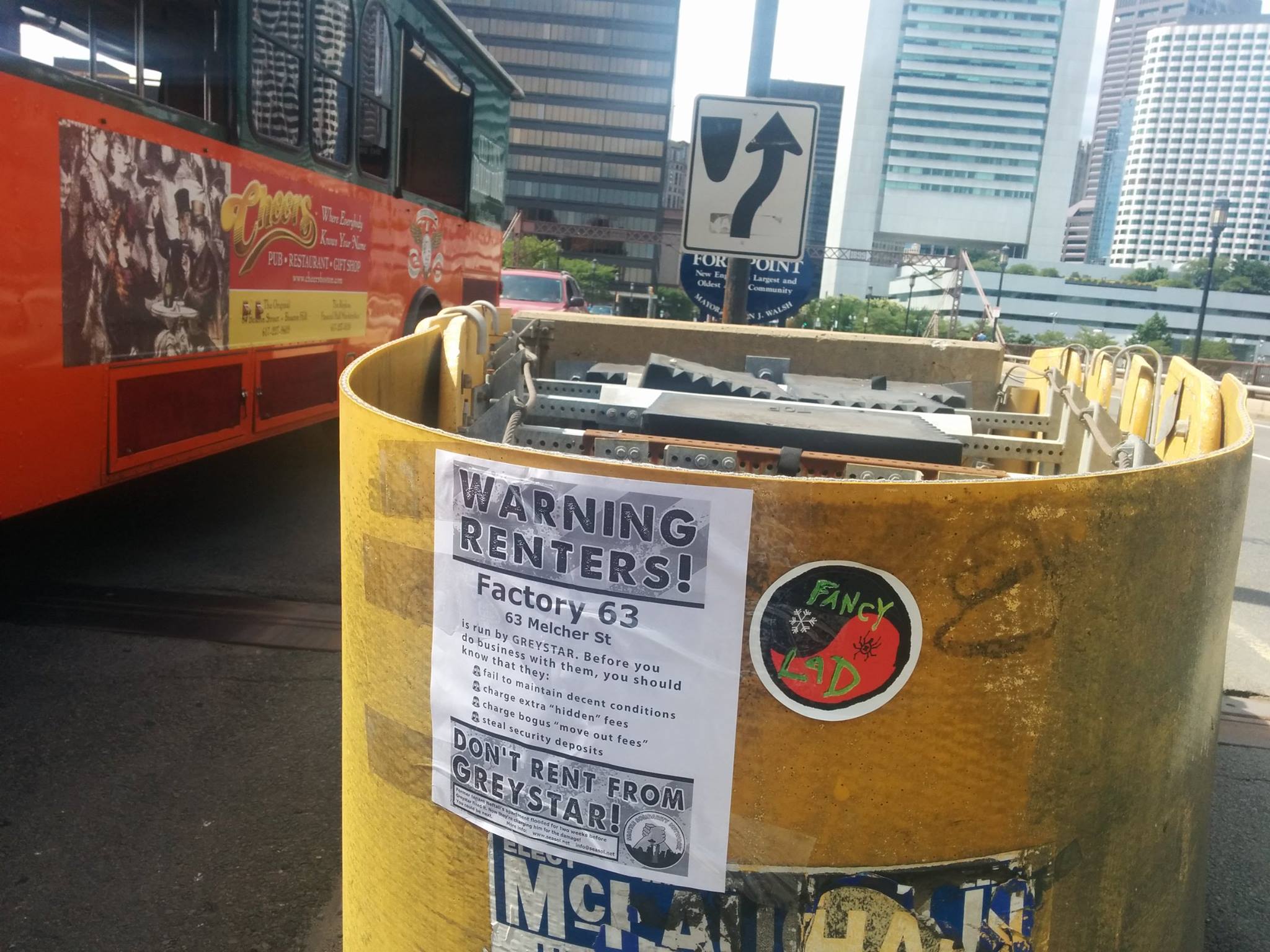
BOSTON, MA
SeaSol reached out to some contacts in the Boston region and luckily, they were happy to show solidarity with our campaign by postering locations in Boston and Quincy.
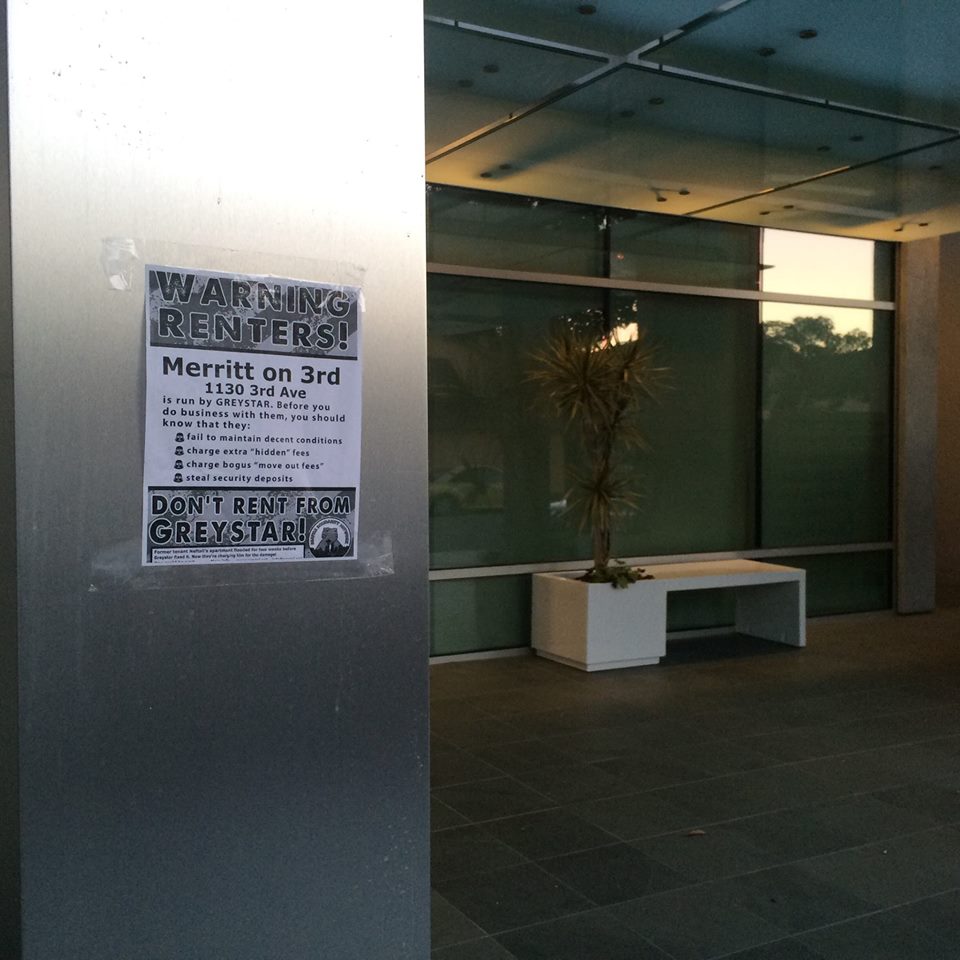
OAKLAND, CA
Oakland, home to some of the most resilient radicals in the United States, was also eager to help. They were able to poster 3 different Greystar properties in the East Bay area. (Greystar Nightmare)
IGD: What would you tell other groups in regards to doing other actions in the future? What could be done better? What would you want them to take away from your experience?
Our initial demand delivery could have gone a bit more smoothly. Our target for the delivery was out of town vacationing in Europe (go figure) which kind of took the wind out of our sails while we were sitting awkwardly in their shiny downtown 6th floor office. We should have had the receptionist who took the demand read it aloud or read it ourselves to her to emphasize the point and to be sure at least somebody heard it. The demand delivery also helped highlight that when planning a specific action that is part of a larger campaign, it is incredibly important to make sure roles for the action are clearly defined so there isn’t any confusion once things get underway. Pretty basic stuff but these kind of things are easily lost in the excitement to kick things off so constantly checking on them and making sure they are follow-through on is critical.
As far as what to tell other groups, I guess I just would like to once more highlight the importance of only taking on fights with the affected individual(s) at the center of them. As I mentioned, this helps build community resilience beyond the shitty paradigm of relying on lawyers that no working-class person can afford and other mechanisms reinforced by the bureaucratic state. I would also say that while you may feel alone in your community as a radical, there are others all over the place that are willing to help as evidenced by our global campaign.
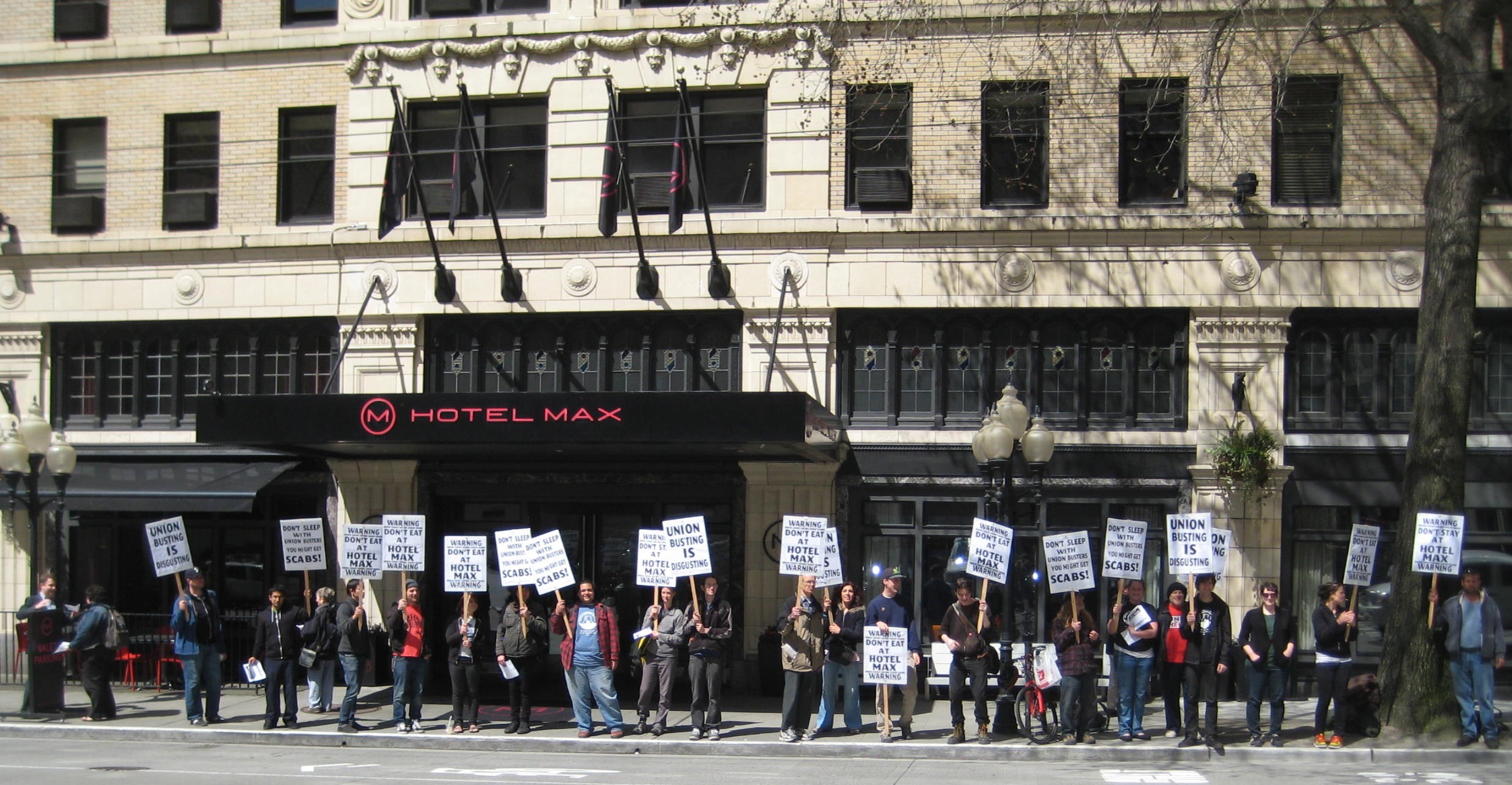
I think the key here to getting other cities and people involved is to keep your requests simple enough but focus on getting them to follow-through with their promises. Not only does this move you toward your desired outcome for the campaign, it also provides a critical networking opportunity that can be used in the future. Just be sure that you are ready to answer their call when it comes time for you and your organization to return the favor because that is what solidarity looks like!
IGD: What do you think the possibilities are for using this tactic of various groups in different cities working on a specific campaign are?
As previously mentioned, the ultimate value of this is the networking opportunities it creates. Beyond that, there is great tactical value in hitting a target from many different sides. By doing so, instead of just one property manager complaining to Greystar’s management we had over a dozen in different states and countries. This really puts a target on their heels and creates, if nothing else, an illusion of us having far greater numbers and power than we may realistically have.
I also think the relatively low amount of effort alongside the potential effect for what we asked of our comrades in other areas really made it effective. Nobody is going to take too kindly to a SolNet from the other side of the globe just calling up and asking them to spend dozens of hours planning a big march in solidarity with a cause but getting an email describing our fight, our goals, and giving them a simple but powerful action such as the region-specific posters to hang up really opened the door for participation elsewhere. These tactics could really be applied to a multitude of campaigns I think.
IGD: In what ways do you think, in theory, that this campaign could have escalated? If they hadn’t come to the table so quickly, what do you think could have take place after their refusal to negotiate? How could this escalation also have translated to other cities and towns?
Some of the possible future actions if they hadn’t have come to the table so quickly would have been disrupting open houses (they have a lot of buildings desperate to fill openings in Seattle; fancy that!), socially targeting the regional top dog (flyer his neighborhood, talk with his neighbors, etc) and other disruptive actions along those lines. As for escalation beyond Seattle, that is a little bit more tricky. We wanted to keep the widespread actions simple to help ensure that folks would actually follow-through with them. I can’t reliably say that we would have been able to get our far-flung comrades to do much more than poster for us. It is definitely an avenue worth exploring though!
IGD: Some people that are critical of the Solidarity Network model state that it is basically street level social work. Also, that while these small victories are good for those involved, they either don’t put out a radical critique of capitalist social relations, or don’t end up changing anything on a wide scale. How would you respond to these criticisms?
Those are fair criticisms and ones I guess I can’t really give an answer to beyond speaking as far as visions go. My personal vision of the role SolNets play and why they are important is twofold. For one, they are a great opportunity to get folks their first taste of an anti-capitalist critique and action. Along those same lines with our model of chain of escalation, it affords our potentially less-radical members a chance to see how more “palatable” actions often go ignored by those we are targeting and the need for more intensive and disruptive actions. Once they are bought into the fight, they are likely to be more open to those more radical actions. This is aided by the fact that we aren’t some mass movement operating under the pretense of “raising awareness” which opens up any action to Liberal handwringers calling for more PR friendly stuff.
Secondly, and I touched on this briefly, the SolNet model can be effective because of the network part of it. Our friend at the center of the last fight knew about SeaSol and came to us because he had worked with us in the past and helped with some fights years ago. That radical education never left him and as soon as some shitty property manager tried to take advantage of him and his family, he stood straight up to them and was enthusiastically ready to take the fight to them. He in turn imparted this upon his husband and father who as far as I know, had not engaged in that type of action before. It can really serve as an educational force to push folks leftward and beyond the awful paradigm most people (even and especially “progressives”) find themselves trapped in.
SolNets aren’t going to be changing the world, that much is true, but I see them as a potentially powerful educational and training force. Many of the people who cut their teeth so to speak with SolNets emerge from the experience having learned consensus-based organizing skills, a greater diversity of tactics and how to implement them, and gain some extremely firsthand critical insight into the inner workings of the capitalist class which can help shape their ideologies for the rest of their lives. Call me an optimist, sure, and yeah this certainly is not always the case but the potential is there and I think it is important that this is acknowledged.
IGD: Anything else you’d like to say? How can people get a hold of SeaSol to learn more or figure out how to start their own SolNet?
Options for contacting SeaSol can be found here.
We are always happy to give some advice to folks looking to start up their own SolNets. There is also a small book that has been made that goes into pretty great detail as far as tools for getting a SolNet started. This was made before I joined so the details on it are sorta foggy for me but I do know that we can get both english AND Spanish copies of it so an email to info@seasol.net would be a great place to start obtaining one of these.
Other than that, all I wanna say is, thanks for your interest in SeaSol and our fight against the disgusting corporation known as Greystar. I highly suggest maintaining vigilance against this company and warning all friends who are renters to avoid them.
STAND UP, FIGHT BACK!
Help out San Jose Solidarity Network in their fight against a landlord here.






